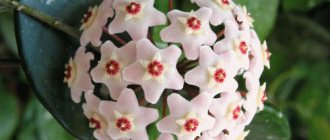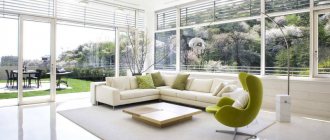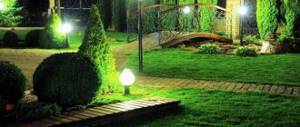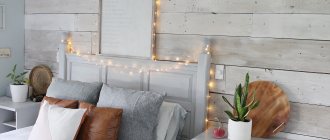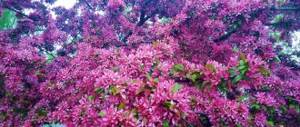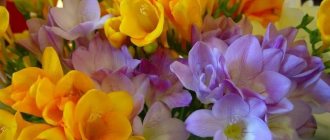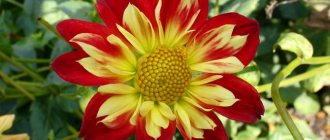Almost all interior publications, magazines and blogs at the beginning of the calendar year talk about trends for the coming year. But it is not clear on what basis the view of trends is based. And if you combine information from different sources, you get a lot of contradictions. How to understand where the truth is?
In my review, I classified as trendy design elements that prevailed or were often encountered among participants in interior exhibitions in Paris and Frankfurt. I talked about what kind of exhibitions these are in the previous introductory article.
In the first review article, we will talk about the most popular element, which in different versions was found in almost every participant - tropical foliage. And I’ll tell you how this design works in the interior.
What interior style does the foliage of tropical plants belong to?
Tropical foliage acts as a separate design element or as a general ecological interior trend. With some stretch and added imagination, it can suit African, Indian or colonial styles. But the foliage does not have a clearly defined relationship to a specific style, so it is successfully suitable for both classical and modern styles:
Wallpaper with palm leaves in country and modern style
Participants in the exhibitions presented the use of tropical foliage in different ways, for some it was an interior with active use of drawings, for others it was a separate decorative leaf or a vase with a houseplant:
Big and small steps towards a trend
Adaptation of animals to living in the subtropics
Porcupine Porcupine
In the tropics, food grows and flutters all year round, but it is not enough. All conditions have been created for invertebrates in the forest, and they grow to large sizes. These are centipedes, snails and stick insects. Mammals are small. There are few herbivores in the forest. There isn't enough food for them there. This means there are few predators feeding on them. There are no animals here that have long horns. They are difficult to navigate in the tropics. Mammals move quietly. Thus, they are saved from overheating.
Interesting:
Do bumblebees make honey? Description, photo and video
Agile monkeys live well in the tropics. They quickly move through the forest, looking for places where a lot of fruit has grown. The monkey's tail replaces its fifth limb. The anteater and the quilled porcupine also have a grasping tail. Animals that could not climb well learned to fly well. They plan easily. They have a leathery membrane that connects the front and back legs.
Options for using tropical foliage in wall decor, furniture, home textiles
Green vector. Designs closely resembling real foliage or with a clear outline pattern
This is an option for fine home landscaping. For walls, you can use wallpaper with foliage textures or photo wallpaper. For furniture and home textiles, textiles depicting tropical trees and foliage:
Artistic image. Hand-drawn foliage designs
Artistic drawings, watercolors, and oils do not have clear contours - this creates a contrast for furniture and decor with clear lines. The interior looks less strict:
Panel with imitation hand drawing and wallpaper with reed pattern
Game of lines. Outline drawings of foliage
If you don’t like green interiors and active floral designs, then take a closer look at what images are created by contour drawings of foliage. Maybe this is what you were looking for:
Livening up a dull beige background. And, wallpaper with tropical foliage in Art Deco style
How did frogs adapt?
Spotted dart frog
High air humidity allows toads and frogs to live far from the river. They live well, living in the upper tiers of the forest. The frogs chose tree hollows for the pond. They coat it with resin from the inside and wait for it to fill with rainwater. The frog then lays eggs there. Dart frogs make holes in moist soil for their offspring.
The male remains to guard the clutch. Then it transfers the tadpoles to the resulting pond formed between the leaves of the bromeliad. Some frogs lay their eggs in a foam nest. They make a nest on branches hanging over the river. The hatched tadpoles immediately fall into the river. Other frogs lay their eggs in damp soil. They come out of there as young individuals.
Interesting:
Why is a zebra striped? Why does a zebra have stripes? Types of zebras and stripes, description, photos and videos
How to combine in the interior. Balance and contrasts
The rules of balance and contrast combinations are written in a separate article.
Balanced combination of textures. Natural natural combinations
Plant drawings have the closest friends: wood, stone, water. Or, elements and materials similar to them. Wood from this trinity will be the closest material.
When paired with a tree, the foliage designs will work to complement each other. Wood is good to add to the interior with leafy prints, and if there is a lot of wood, then bright leafy designs will dilute the space, create accents and balance the interior. The photo example contains options for balancing texture combinations. Pillows with bright green foliage harmonize well with wicker chandeliers, a plank wall, a mat, stone and glass vases, and a leather sofa completes the picture:
A few more examples of combinations. Creepers and wooden decorations are close to the natural image and will fit well into the interior with foliage. Take a look at examples of how a clothes hanger and stair railing are designed:
A chandelier made of vines looks alien in a faceless interior, but they would be akin to tropical foliage:
Contrasting combination
The contrasting combination of tropical foliage will be expressed in pattern, texture, and color. Intuitive contrast will create contrasts between foliage as natural and natural to technical and modern elements and forms. Contrasting combinations are needed to add color or semantic diversity to the interior. Look at examples of contrasting combinations of metal, plastic products, angular shapes, and modern furniture models with leafy prints:
Types and description of plants
According to the California Institute of Technology, more than 2/3 of the world's plant varieties are found in tropical forests. Some common types of tropical vegetation include orchids , epiphytes, and sweet figs. Orchids make up the most diverse group of plants. In tropical conditions, they often grow on trees, although they do not lead a parasitic lifestyle. Blooming orchids appear in different shapes and sizes.
List of plants that belong to the nightshade family
Epiphytes are plants that live on other plants. Epiphytes, or “air plants,” grow almost everywhere in these forests, but most often thrive on tree branches, trunks, and leaves. They do not have roots in the ground and have evolved other methods to obtain water and nutrients. Sometimes one tree can be home to many types of epiphytes, together they weigh several tons. Epiphytes even grow on other epiphytes.
Epiphytes produce a much larger number of seeds than earth plants because many seeds never find ideal places to grow and therefore die. Other epiphytes, such as orchids, lichens, mosses and bromeliads, compete for space to reproduce on trees. According to tropical forest data, there is an excess of 15,000 epiphytes in the neotropical zone.
Diversity of epiphytes
Tropical forests include flowers with special adaptations, trees with unusual root structures, and many plants that are used by humans either to produce food or to create other goods and products.
Main types of epiphytes:
- Bromeliads. The most common are bromeliad epiphytes. Bromeliads are flowering tropical plants whose names are sometimes difficult to pronounce. They attach themselves to a tree by wrapping their roots around its branches. Their leaves direct water to the central roots. Bromeliads are a habitat unto themselves. Water is used not only by vegetation, but also by many animals in tropical forests. Birds and mammals drink from the leaves, which collect water. Tadpoles grow there, and insects lay larvae.
- Carnauba palm. This Brazilian palm is also known as the "tree of life" because it has many beneficial uses. Its fruits are eaten and its wood is used in construction. It is also best known as a source of carnauba wax, which is obtained from the leaves of the tree. Carnauba wax is used in car polishes, lipsticks, soaps and many other products. They even rub it on surfboards to make them glide faster through the water.
- Rattan palm. There are more than 600 species of rattan palm. All of them grow in African, Asian and Australian tropical thickets. Rotans are vines that cannot support themselves. Instead, they wrap themselves around other trees. Captured thorns on the stems allow them to climb other trees towards the sunlight. Rotans are collected and used in furniture construction.
- Walking palm trees. Walking palms grow in the tropical forests of Central and South America. They have connected roots that protrude from the trunk above the ground. It was once believed by local people that these roots allowed trees to "go" to a new location if they were rejected by the tree. Scientists believe that the roots simply improve their stability.
- Indian bamboo. Bamboo is the most interesting type of tropical plant. Some types of bamboo can grow 90cm (3ft) in one day. Indian Forest Bamboo is a particularly useful type of bamboo as it is used to make furniture. And also for creating paper products and musical instruments. It grows in the tropical forests of South Asia.
- Rubber tree. The rubber tree was first discovered in the Amazon forest and is now also grown in tropical areas of Asia and Africa. By collecting the milky liquid found in the vessels and bark, the tree is grown to create latex. These vessels open and the latex that leaks out is collected in buckets. There are more than 1.9 million rubber trees in the Amazon rainforest. Latex is used to make natural rubber. Natural rubber has many uses, including car tires, hoses, belts and clothing.
- Bougainville. The plant is native to South America. It is most often grown as a decorative element. Bougainvillea is well known for its beautiful flower-like leaves that grow around the actual flower. These thorny plants grow in the same way as vines and shrubs.
What types of herbs and plants are there?
Rare representatives
Despite their diversity, every year more and more tropical plant species disappear from the face of the Earth. That is why most of the names are included in the Red Book.
Names of tropical plants that are endangered:
- Vanilla orchid. Vanilla orchid was first used as a flavoring by the Aztecs. Today, the word "vanilla" is usually used to describe the flavor rather than the plant from which it comes. Vanilla orchids grow like vines, climbing up other trees. Wild vanilla orchids are pollinated by hummingbirds and bees. They grow in Central and South America.
- Amazon water lily. The Amazon water lily is an aquatic plant that grows in the lakes and rivers of South American rainforests. Its huge leaves can be up to 3 meters in diameter. The undersides of the leaves have rows of sharp spines. They help protect against animals that are in such forests and feed on vegetation.
- Pitcher plants. No list of tropical forests would be complete without a carnivorous plant. Pitcher plants are an enemy of insects. They grow in areas where the soil is poor in nutrients. There are many different types of such flowers, but they all hunt in the same way - luring insects with nectar or seductive odors. After which the insects land on attractive leaves, and due to the fact that there is a sticky liquid on the plant, they cannot fly away.
- Durian. Durian trees grow in Southeast Asia. Their fruits are famous for their strong smell. Some people like the smell, but others find it repulsive. Despite this, its fruit is a popular delicacy.
Tropical forests play an important role in ecological restoration around the world. Plants in tropical areas provide food for animals, as well as stabilize the global climate, help prevent drought and erosion, provide medicine to people, and make up attractive natural environments for tourism.
What's next for tropical foliage fashion?
Interior fashion is not as fleeting as clothing fashion. If a direction appears, it lasts not for half a year or a year, but for decades. People started talking about tropical foliage as a trend around 2014 and, as recent exhibitions have shown, its popularity is not going away, but only growing. And there are quite logical explanations for this - people are tired of technology, they want peace of mind. And peace is given by nature and its images.
Perhaps in the future, instead of foliage patterns, home greenhouses with automatic watering and artificial lighting will come into fashion, but the theme of nature will not go away from our interiors, but will continue to grow.
Pollination of flowers
For pollination, flowers must attract insects, birds or bats. They attract with their bright color, smell and delicious nectar. To attract their pollinators, even the plants of the upper tier decorate themselves with beautiful flowers. Moreover, during flowering they even shed some of their leaves so that their flowers stand out more noticeably.
Interesting:
Why does a chameleon change color?
To attract insects, orchids secrete nectar, which makes bees drunk. They are forced to crawl on the flower, pollinating it. Other types of orchids simply slam shut, showering the insect with pollen.
But it’s not enough to pollinate the flowers; you also need to spread the seeds. Seeds are dispersed by animals. To attract them, plants offer them tasty fruits with seeds hidden inside. The animal eats the fruit, and the seed comes out along with excrement, fully capable of germination.
Agouti and nut
Sometimes plants reproduce with the help of only one type of animal. Thus, the American walnut reproduces only with the help of the large rodent agouti. Although agoutis eat all the nuts, they bury some of them in the ground. Our proteins also make such a reserve. Forgotten seeds sprout.
Where to watch and buy
In this section I will present interior products with the theme of tropical foliage and trees that are already available for purchase. And in a separate block “Added”, new products will be added throughout the year that were not on sale at the time of writing.
Wallpaper with tropical foliage design
To order with delivery throughout Belarus, look at a separate selection of tropical designs from the wallpaper catalog of the online store oboivdom.by
To view and buy wallpaper in Minsk, look at the selection from the online catalog of the 7×7 showroom store Minsk, Uruchye
Home textiles: curtains, bedspreads, pillows
Textiles with designs of tropical foliage and trees are available in the 7×7 showroom.
Also, in the salon you can order individual tailoring of curtains, bedspreads, pillows or buy ready-made products.
Climate adaptation
Plants need water to survive, but in tropical areas the problem is often not that there is not enough water, but that there is too much. Plants living in such forests must be able to survive in areas that receive a lot of rain and even experience flooding. Many plants have waxy leaves that help repel rain. Tree leaves have a drip tip that is designed to allow rain to drain quickly from them.
Growing and caring for Arabica coffee indoor plants
All living organisms need sunlight to survive , but the dense vegetation of the upper layers of forests in the tropics prevents sunlight from reaching the plants. Rainforest vegetation either had to adapt to living with little sunlight under the forest canopy, or grow rapidly and find ways to reach sunlight above the canopy.
For example, vines grow quickly along tree trunks and branches to reach sunlight. Some flora, such as the strangler fig, actually begin life high above the ground, thereby capturing the necessary sunlight immediately. They grow slowly to the ground and the roots eventually reach the soil.
The soil in most tropical forests is very poor and lacks nutrients. A small number of them are located on the top of the soil; the deeper the roots of the plant, the less nutrition they receive. To capture richer nutrients in the top soil, most trees have shallow roots. Some trees have developed small roots from large roots. These roots grow from the trunk well above ground level (often several centimeters above ground level), providing essential support for the tree to capture nutrients in shallow soil.
High humidity and heavy rain allow some plants to actually grow without soil. This type of vegetation is called air plants. They get nutrients from plant debris and bird droppings that land on the roots. Thus, they do not depend on the poor soil of the forest.
Textile
Our favorite item! Bright textiles will decorate almost any interior style. A tropical pillow can stand alone as an accent piece without the support of other elements. We think that one or two printed pillows and a few plain ones would look best on a sofa.
A set of cheerful curtains and pillowcases is perfect for a cheerful children's room.
Orchid
Orchids are the largest plant family in the world. Species vary greatly in weight and size, with some petals reaching 75 cm in length and inflorescences growing up to 3 m in length. They can also come in a variety of colors, with the exception of black. Orchids grow on rocks, in soil, underground and on other plants, relying on certain insects or birds for pollination.
Distribution: Extremely well adapted and grows in Central America, South America and along the Andes Mountains.
What would you do if you didn't have a cup of coffee in the morning? Surely it would be terrible. You can thank the rainforest coffee plant for your coffee. It is capable of growing up to 9 m in height, but is considered a bush or shrub. Coffee fruits resemble grapes and contain two coffee beans inside. It takes six to eight years for the plant to grow, and its lifespan can reach 100 years.
Bromeliads
Bromeliads include more than 2,700 species that grow on the ground, on rocks and on other plants. These beautiful plants have colorful flowers. One of the most famous members of the bromeliad family is the sweet, wonderful fruit, the pineapple! Bromeliads even sometimes provide shelter for frogs, snails and salamanders, where they remain for life.
Distribution: Central and South America. One species is also found in West Africa.
The rainforest is home to many amazing plants, including those that many of us enjoy; therefore, it is very important to preserve this unique ecosystem. Imagine living without bananas, coffee, chocolate, pineapples and beautiful orchids. This is absolutely sad!
Bananas
Bananas are one of the amazing plants of the rainforest. Even though they look like trees, bananas are not trees but giant herbaceous plants. After a year, they reach a full height of 3 to 6 m. The flowers eventually develop into fruits and then mature and are used as food by humans and animals. Banana stems can weigh almost 45 kg and are almost 93% water.
Distribution: Central America, South America, Africa, Southeast Asia, and non-tropical regions such as the United States due to modern agricultural technology.
Beautiful spurge
This beautiful plant is found in tropical forests in the form of a bush or tree. You might think that the red part of the plant is the flowers, but they are actually bracts. The flowers are small yellow clusters in the middle of the leaves. Also, to clear up the rumors, they are not poisonous, although some believe they are.
Distribution: Mexico and Central America.
Heliconia
This genus of plants includes almost 200 species distributed in tropical America. Depending on the species, these plants can grow up to 4.5 m in height. Flowers can be colored in shades of red, orange, yellow and green. The bracts actually hide the plant's flowers and protect the nectar so only certain birds, such as hummingbirds, can reach them. Butterflies also love to feast on sweet nectar.
Distribution: Central and South America.
Furniture
Printed furniture is dangerous territory. The main principle here is not to overdo it. One item - an armchair, sofa or chest of drawers - will be enough to hint to guests about your passionate love for the jungle and adventure. Of course, such items look best in the colonial style, although there is a place for them in modern eclecticism.
A cheerful chest of drawers with the name of the famous meerkat Timon from the cartoon “The Lion King”. It can decorate both a bedroom or hallway, and a living room.
The couch with playful legs and the ottoman stool are covered with fabric from the same collection and can easily be combined with each other. True, we would advise not to put such things next to each other. Let, for example, a sofa be in the living room, and an ottoman decorate the bedroom, as if hinting that the apartment has stylistic elements that connect the room.
Spectacular wallpaper is a radical way to transform a space. Options with tropical leaves are so catchy that you can’t overuse them: it’s better to stick wallpaper that’s too dynamic only on one accent wall so that it doesn’t start to irritate you after a month.
The interesting watercolor wallpapers that we found have a special feature: they can be re-pasted several times. The manufacturer claims that the wallpaper is easy to glue yourself and does not form irritating air bubbles.
The famous wallpaper model with palm leaves from the English company Cole & Son is available in four colors: classic blue (as on the left), dark brown (as on the right), yellow and beige. This wallpaper is very popular and can be found in many design projects now. True, their price is quite high.
The following wallpapers that we give as examples are very unusual. It’s definitely impossible to decorate a boring apartment with them. You can find the first (lush green) here, the second (with a geometric base) here, and the last (very dynamic) here.
